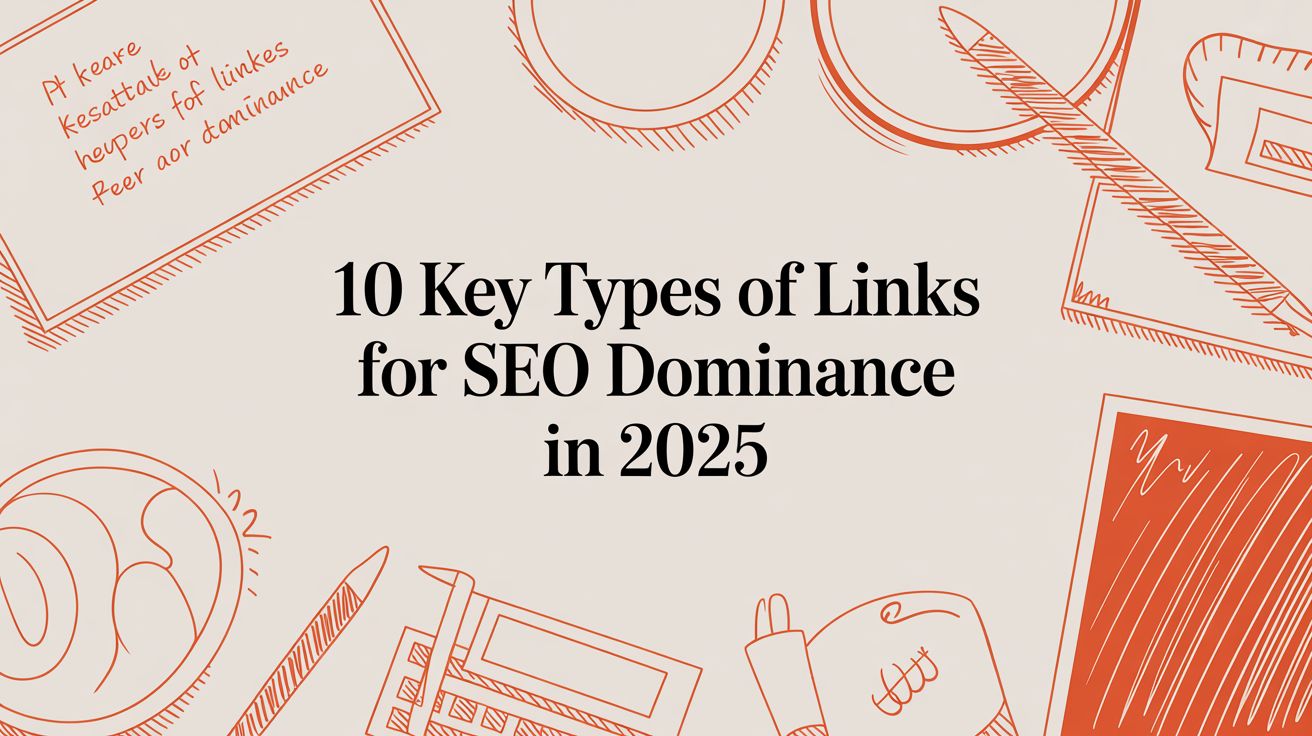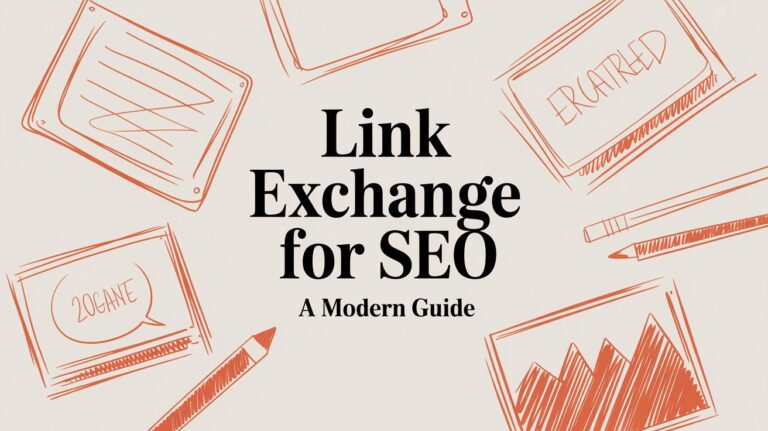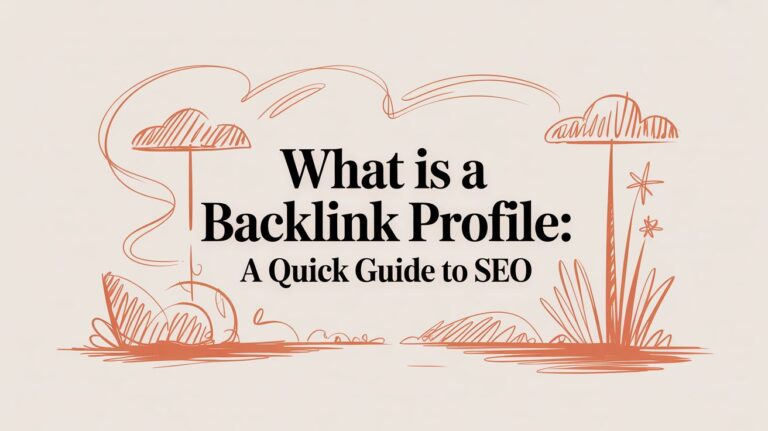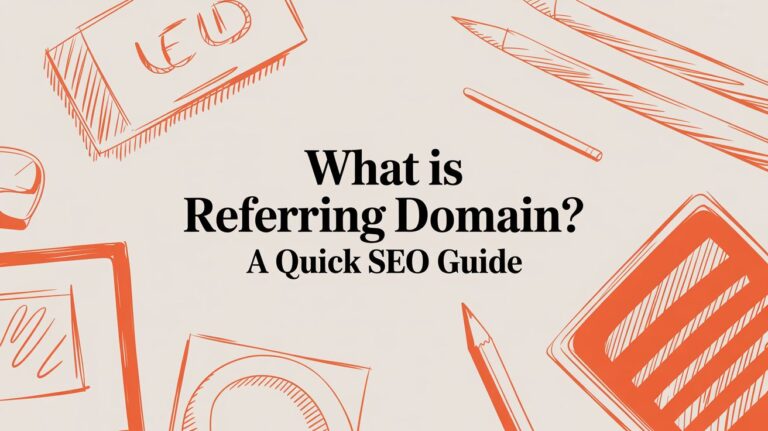10 Key Types of Links for SEO Dominance in 2025
In SEO, not all links are created equal. For busy founders, developers, and agency owners, understanding the different types of links is key to building a scalable, cost-effective growth engine. A single high-quality backlink can outperform a thousand weak ones, while a smart internal linking strategy can unlock your site's hidden authority.
This guide goes beyond generic advice to give you an actionable roundup of the link types that truly matter. We'll break down what each one is, how it impacts your rankings, and how to manage them effectively. Forget abstract theories—this is a practical playbook for building a powerful link profile.
You will learn to differentiate between crucial link categories, from foundational internal links that structure your site to powerful contextual backlinks that drive authority. We will cover the strategic use of nofollow vs. dofollow tags, the importance of anchor text, and even how technical elements like 301 redirects function as links. This resource will help you build a resilient backlink profile without the guesswork. By the end, you'll have a clear framework for making linking decisions that directly contribute to your organic growth.
1. Internal Links
Internal links are hyperlinks that connect one page on your website to another page on the same site. Of all the types of links, these are the only ones you completely control. They form your website's structural backbone, guiding users and search engine crawlers through your content, distributing authority (or "link juice"), and establishing a clear site hierarchy.
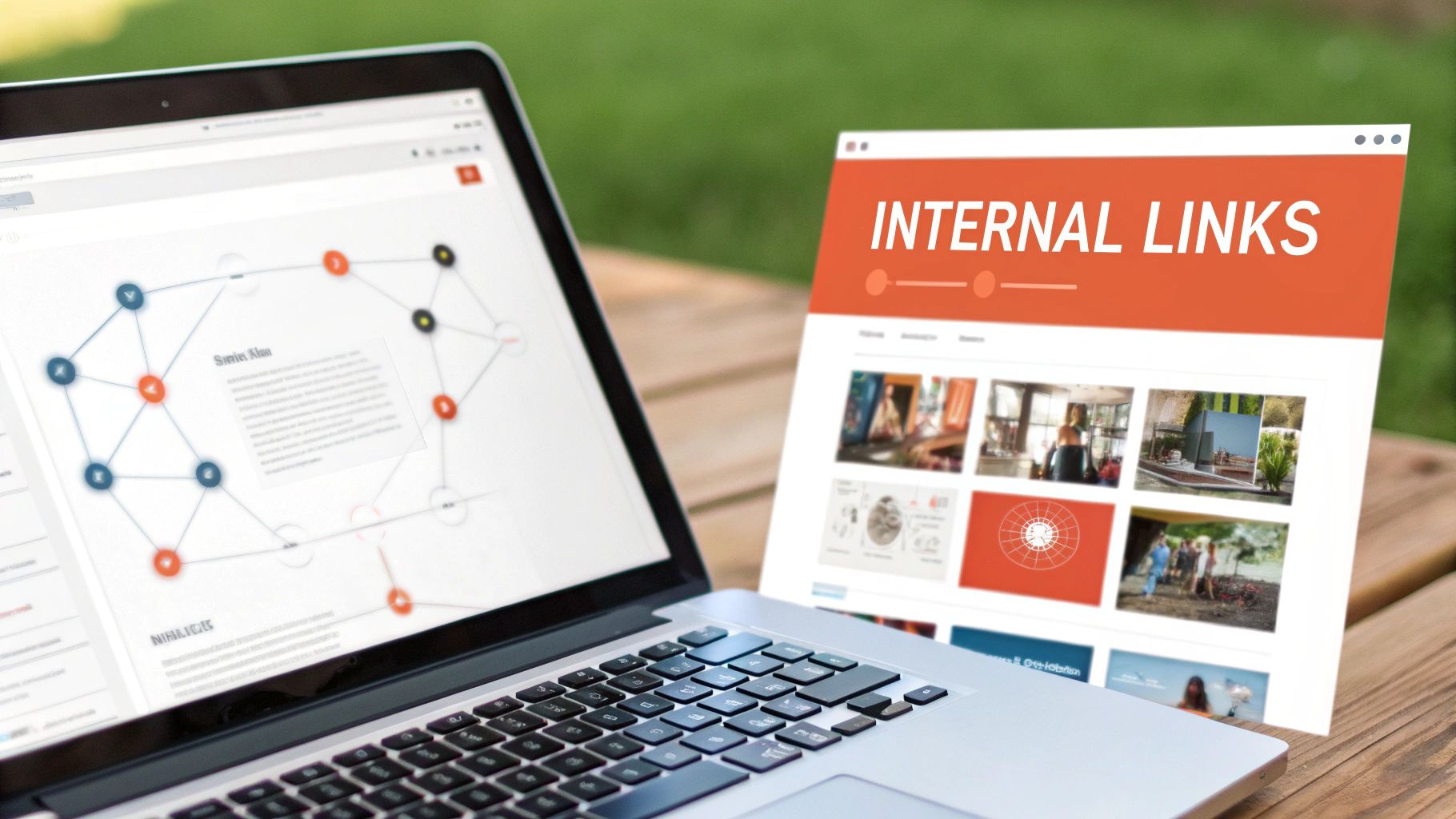
Why Internal Links Are Critical
A smart internal linking strategy is essential for any serious website. It helps search engines understand the relationships between your pages, highlights your most important content, and makes your site easier to crawl. For users, it improves their experience by making related information easy to find, which increases time on site and reduces bounce rates.
Actionable Strategies for Implementation
To maximize the power of internal links, don't just add them randomly. A strategic approach is required.
- Use a Topic Cluster Model: Create a central "pillar" page for a broad topic and link it to "cluster" pages that cover related subtopics. Then, link from the cluster pages back to the pillar. HubSpot's resource centers are a perfect example of this model.
- Use Descriptive Anchor Text: Avoid generic phrases like "click here." Instead, use keyword-rich text that tells users and search engines what the destination page is about. For instance, use "our guide to SaaS pricing models" instead of "read more."
- Link From High-Authority Pages: Identify pages with the most traffic or backlinks. Add internal links from these pages to new or important content you want to boost in search rankings.
- Conduct Regular Audits: Use tools like Ahrefs or Screaming Frog to find and fix broken internal links and identify "orphan pages" (pages with no internal links). This ensures link equity isn't wasted and all your content is accessible.
2. External Links (Outbound Links)
External links, or outbound links, are hyperlinks that point from your domain to a different, external domain. While internal links build your site’s structure, external links connect your content to the wider web. They act as citations, showing your content is well-researched and references authoritative sources, which enhances your topical authority.
Why External Links Are Critical
Strategic external linking signals credibility and provides value to your readers. By linking to high-quality resources, you position your content as a reliable source of information, building trust with your audience. For search engines, these links help them understand your content's context and niche, associating your page with other authoritative sites. Think of it as citing your sources—it adds weight to your claims.
Actionable Strategies for Implementation
Use external links effectively by focusing on quality and relevance, not just quantity.
- Link to Authoritative, Relevant Domains: Only link to credible websites directly relevant to your topic. Citing a university study, a well-known industry publication, or a government statistics page adds significant value.
- Use the "nofollow" Attribute for Untrusted Sources: If you link to a site you don't fully endorse or to a sponsored link, use the
rel="nofollow"attribute. This tells search engines not to pass authority to the destination page. - Open External Links in a New Tab: To improve user experience and keep visitors on your site, make external links open in a new browser tab by adding
target="_blank"to the link's HTML. - Audit for Broken Links: Use a tool like Ahrefs or Screaming Frog to periodically check for broken outbound links. Fixing these ensures you aren't sending users to dead pages, which creates a poor user experience.
3. Backlinks (Inbound Links)
Backlinks, or inbound links, are hyperlinks from external websites pointing to yours. Among all types of links, these are arguably the most powerful SEO ranking factor, acting as a third-party vote of confidence. When a reputable site links to you, it signals to search engines that your content is valuable and trustworthy, which can significantly boost your rankings.

Why Backlinks Are Critical
A strong backlink profile is a cornerstone of any successful SEO strategy. High-quality backlinks drive referral traffic, build brand authority, and help search engines discover your content faster. For SaaS companies and agencies, a network of backlinks from industry publications is a competitive advantage that is difficult for rivals to replicate.
Actionable Strategies for Implementation
Earning quality backlinks requires a proactive strategy. Simply creating content and waiting for links isn't effective.
- Create Linkable Assets: Develop original research, free tools, in-depth guides, or compelling infographics. These assets naturally attract links from others looking to cite authoritative sources.
- Leverage Digital PR and Outreach: Build relationships with journalists, bloggers, and industry influencers. Pitch them unique stories or expert commentary they can feature in their content with a link back to your site.
- Guest Post on Reputable Blogs: Write high-quality articles for established websites in your niche. This earns you a relevant backlink and exposes your brand to a new, targeted audience.
- Monitor Your Backlink Profile: Regularly audit your inbound links using tools like Ahrefs or SEMrush. This helps you identify and disavow toxic links that could harm your rankings. Understanding your backlink profile is the first step to managing it well.
4. Nofollow Links
Nofollow links contain a rel="nofollow" attribute, which tells search engines not to pass authority or "link equity" to the destination URL. Introduced to combat comment spam, this tag is now used for links a site owner doesn't fully endorse, like paid links or user-generated content. While they don't directly pass SEO authority, these types of links can still drive traffic and build brand awareness.
Why Nofollow Links Are Critical
Using the nofollow attribute correctly is crucial for a healthy link profile. It signals to search engines which links are advertisements or not editorially vouched for, helping you avoid penalties related to paid link schemes. For example, Wikipedia applies the nofollow attribute to all external links. Using them correctly protects your site's integrity and follows webmaster guidelines.
Actionable Strategies for Implementation
Applying the nofollow attribute is a key part of responsible site management.
- Tag All Paid and Sponsored Content: Any link that has been paid for—including affiliate links, ads, or sponsored posts—must use a nofollow (or the more specific
rel="sponsored") attribute. This is a non-negotiable guideline from Google. - Apply to User-Generated Content (UGC): Automatically apply the nofollow tag to links in comment sections and forum posts. This prevents spammers from exploiting your site to build low-quality backlinks.
- Avoid Outdated "Link Sculpting": Marketers once used nofollow internally to channel authority to specific pages. This practice is now ineffective. Focus on a natural internal linking structure instead.
- Audit Your Outbound Links: Regularly review external links to ensure paid or untrusted links are correctly tagged. This is vital if you participate in partnerships that could be seen as unnatural. For more details, you can explore link exchange practices for SEO.
5. Dofollow Links
Dofollow links are the default type of hyperlink that passes SEO value, or "link equity," from one website to another. When a search engine crawler sees a link without a nofollow attribute, it follows it and passes authority to the linked page. These are the most valuable types of links for SEO, as they directly influence a page's ability to rank in search results.
Why Dofollow Links Are Critical
A healthy profile of dofollow links from reputable, relevant websites is a powerful signal to search engines that your content is credible. Each dofollow link acts as a vote of confidence, telling Google that others trust your information. A steady accumulation of these links from diverse, high-authority domains is one of the biggest factors in improving your organic search visibility.
Actionable Strategies for Implementation
Earning quality dofollow links is an active process that requires creating content people genuinely want to reference.
- Create Link-Worthy Assets: Develop original research, comprehensive guides, free tools, or unique data studies. This "linkbait" content naturally attracts mentions from journalists, bloggers, and experts. A SaaS company could publish a "State of the Industry" report, for example.
- Focus on Relationship Building: Engage with influencers and journalists in your niche without an immediate ask. Share their content and provide value first. They will be more receptive to your outreach when you have relevant content.
- Analyze Competitor Backlinks: Use SEO tools like Ahrefs to see who is linking to your competitors. This gives you a roadmap of high-authority sites that are already linking to content like yours, providing a list of prime outreach targets.
- Pursue High-Quality Directories and Resource Pages: Find reputable, human-edited industry directories and resource pages. A dofollow link from a well-respected resource, like a university's library guide, can be highly valuable.
6. Contextual Links
Contextual links are hyperlinks naturally embedded within the body of your content, like a paragraph or list. Unlike links in footers or sidebars, these are placed editorially within the text. Their power comes from the surrounding content, which provides context to users and search engines about the destination page's relevance, making them one of the most valuable link types for SEO.
Why Contextual Links Are Critical
Google's algorithms are designed to understand topical relevance, and contextual links are a primary signal. When you link to a resource from within a relevant sentence, you are vouching for its quality. This passes significant authority and relevance signals, which can have a much greater impact on rankings than a link placed in a non-editorial part of a page.
Actionable Strategies for Implementation
Placing contextual links effectively requires a thoughtful, user-centric approach.
- Prioritize Natural Placement: Embed links where they make sense within a sentence. The link should feel like a natural part of the text, not a forced interruption. Wikipedia is a great example, where terms are linked to their respective articles, creating a seamless experience.
- Use Descriptive Anchor Text: Your anchor text should clearly describe the content of the linked page. Instead of "learn more," use a specific phrase like "our complete guide to content distribution."
- Ensure High Topical Relevance: Only link to pages that add value and are directly related to your subject. A link from an article about SaaS metrics to a page about gardening is irrelevant and offers no value.
- Audit for Flow and Density: Read your content aloud to check if links disrupt the natural reading flow. Avoid over-linking; a few highly relevant contextual links per section are more effective than stuffing them in.
7. Branded Links
Branded links are a powerful type of link where the anchor text is your company name, product name, or brand variation. These hyperlinks act as direct citations, signaling to search engines that your brand is a recognized entity. When authoritative sources link to you using your brand name—like a tech publication citing 'Slack'—it builds immense trust and brand equity.
Why Branded Links Are Critical
A healthy backlink profile looks natural, and branded links are a key part of that. They indicate brand popularity and trustworthiness, which Google's algorithms value. An over-reliance on exact-match keyword anchors can appear manipulative, whereas a high volume of branded links suggests genuine, earned media attention. This makes them crucial for establishing long-term authority.
Actionable Strategies for Implementation
Earning branded links is a result of building a strong brand presence and creating noteworthy content.
- Monitor and Claim Brand Mentions: Use tools like Brand24 or Google Alerts to find online mentions of your brand that aren't linked. Politely reach out to the publisher and ask them to add a hyperlink. This "link reclamation" is a high-success strategy.
- Create Press-Worthy Assets: Develop original research, data studies, or company announcements that journalists will want to cite. When they reference your findings, they will naturally link to your brand name.
- Build Relationships with Industry Media: Nurture connections with journalists and influential bloggers. By becoming a reliable source for quotes or insights, you increase the likelihood of receiving branded links when they cover relevant topics.
- Optimize Your Social Presence: A strong social media presence encourages sharing and discussion, which often leads to bloggers or customers linking to your brand name in their content. This helps diversify these essential types of links.
8. Anchor Text Links
Anchor text is the visible, clickable text within a hyperlink. While not a distinct link category, its optimization is a critical part of link-building. It is one of the strongest signals search engines use to determine a linked page's topic. Well-optimized anchor text provides powerful contextual clues to both users and crawlers, directly impacting rankings for all types of links.
Why Anchor Text Is Critical
Effective anchor text management is fundamental to SEO. It bridges the gap between your content and the pages you link to, helping search engines understand relevance. For users, descriptive anchor text sets clear expectations, improving navigation and trust. A poor anchor text strategy, conversely, can confuse search engines and even trigger spam filters.
Actionable Strategies for Implementation
Optimizing anchor text requires a strategic and natural approach. The goal is to provide context without appearing manipulative.
- Diversify Your Anchor Text Profile: A natural backlink profile has various anchor types. Aim for a healthy mix: branded anchors ("Outrank's guide"), naked URLs ("www.outrank.so"), partial-match keywords ("learn about these types of links"), and some exact-match keywords ("SEO link building"). Over-optimizing with exact-match anchors is a red flag.
- Prioritize Descriptive and Relevant Text: Your anchor text should accurately describe the linked page. Instead of "click here," use "see our full link building case study." This informs the user and provides rich context for search crawlers.
- Match Anchor Text to User Intent: Consider what a user wants to find when they click. The anchor text should align with that intent. If linking to a pricing page, an anchor like "view our pricing plans" is more effective than a generic keyword.
- Conduct Anchor Text Audits: Use tools like Ahrefs or Semrush to analyze your backlink anchor text profile. Look for signs of over-optimization (too many exact-match anchors) or too many generic anchors. You can then prioritize building links with more diverse text to balance your profile.
9. 301 Redirects and Link Permanence
A 301 redirect is a permanent directive that forwards one URL to another. While not a link you build, it is crucial for preserving your SEO value. It tells search engines a page has moved for good and that they should transfer nearly all of its link equity (90-99%) to the new destination. This is essential for maintaining a seamless user experience and preventing link value from being lost during website updates.
Why 301 Redirects Are Critical
Implementing 301 redirects is a fundamental practice in technical SEO. Whenever you change a URL or delete a page, failing to set up a 301 redirect means any backlinks pointing to the old URL are lost, which can cause a significant drop in rankings. Properly managed redirects ensure that users and search engine crawlers are sent to the correct, live page, safeguarding your traffic and authority.
Actionable Strategies for Implementation
A proactive and organized approach to redirects is vital for any website undergoing changes.
- Map All URL Changes: Before a site redesign, create a spreadsheet mapping every old URL to its corresponding new one. This "redirect map" is your blueprint for implementation and a critical document for reference.
- Audit for Redirect Chains: A redirect chain occurs when one URL redirects to another, which then redirects again (e.g., Page A -> Page B -> Page C). These chains slow your site and dilute link equity. Use a tool like Screaming Frog to find them and point the initial URL directly to the final destination.
- Handle Site Migrations Carefully: When moving from HTTP to HTTPS or to a new domain, implement sitewide 301 redirects. This involves setting up rules on your old server to forward all traffic and link value to the new one.
- Monitor for 404 Errors: Regularly use Google Search Console to check for "Not Found (404)" errors. These reports show where users are trying to access pages that no longer exist. If these old URLs have valuable backlinks, implement a 301 redirect to the most relevant live page to reclaim that link equity.
10. Citation and Schema Markup Links
Citation and Schema Markup links are a sophisticated hyperlink type embedded within structured data, like Schema.org markup. These aren't standard on-page links; they are machine-readable annotations that give search engines explicit context about entities and their relationships. Among the many types of links, these semantic connections are crucial for building topical authority and qualifying for rich results in SERPs.
Why Citation and Schema Links Are Critical
In today's semantic web, a simple link isn't enough. Schema markup links tell search engines exactly what a link represents: a link to an author's profile, a citation for a claim, or an organization's official website. This removes ambiguity and helps Google understand your content more deeply, which can lead to rich snippets, knowledge panels, and a stronger E-E-A-T (Experience, Expertise, Authoritativeness, Trustworthiness) profile.
Actionable Strategies for Implementation
To leverage semantic links, you must integrate structured data into your HTML, typically using the JSON-LD format recommended by Google.
- Implement Entity-Specific Schema: Use
Articleschema to link to an author's official profile (author.url) or the publisher's page (publisher.url). For local businesses,LocalBusinessschema can include a link to your officialurlandsameAslinks to social profiles. - Use
citationfor Academic Content: When referencing studies or papers, use thecitationproperty within theScholarlyArticleorClaimReviewschema. This creates a verifiable link that signals credibility. - Validate Your Markup: Always test your structured data with tools like the Google Rich Results Test before and after deployment. This ensures there are no syntax errors preventing search engines from parsing the information.
- Keep Data Consistent and Current: Ensure the information and links within your schema markup are up-to-date and consistent with the linked pages. Regularly monitor your structured data reports in Google Search Console to catch any errors.
10 Link Types Compared
| Link Type | Implementation Complexity | Resource Requirements | Expected Outcomes | Ideal Use Cases | Key Advantages |
|---|---|---|---|---|---|
| Internal Links | Low–Medium (strategic planning) | Low (editor time, audits) | Improved crawlability, distributed authority, better navigation | Site structure, pillar/cluster pages, e‑commerce categories | Full control, boosts SEO and UX, retains users |
| External Links (Outbound) | Low (curation) | Low–Medium (vetting sources) | Adds credibility and topical relevance; may drive users offsite | Citations, further reading, research references | Establishes trust, supports claims, improves UX |
| Backlinks (Inbound) | High (acquisition & outreach) | High (content, PR, outreach) | Strong ranking improvement, domain authority, referral traffic | Authority building, competitive SEO campaigns | Major SEO ranking signal, third‑party validation |
| Nofollow Links | Low (attribute addition) | Low (policy + tagging) | Referral traffic without PageRank transfer; compliance signaling | Sponsored posts, UGC, comment sections, paid links | Protects SEO, reduces spam risk, ensures compliance |
| Dofollow Links | Medium–High (earning quality links) | Medium–High (content + outreach) | Transfers authority and PageRank; improves rankings if high‑quality | Editorial mentions, reviews, natural citations | Passes SEO value, signals editorial endorsement |
| Contextual Links | Medium–High (editorial placement) | Medium (quality content required) | High SEO value and CTR; signals topical relevance | In‑article references, supporting resources, news | Most valuable placement; improves relevance and UX |
| Branded Links | Low–Medium (brand promotion) | Medium (PR, content) | Strengthens brand authority and entity signals | Press coverage, brand mentions, social citations | Boosts brand recognition; safer for algorithms |
| Anchor Text Links | Low (text selection) | Low (content editing) | Conveys page topic to users and bots; affects CTR | Any internal/external links where intent clarity matters | Improves relevance signals and accessibility |
| 301 Redirects & Link Permanence | Medium–High (technical setup) | Medium (dev work, mapping) | Preserves most PageRank and UX during URL changes | Site migrations, URL restructures, deleted pages | Maintains link equity and prevents 404s |
| Citation & Schema Markup Links | High (technical, structured data) | Medium–High (dev, validation) | Better entity understanding, rich snippets, Knowledge Graph potential | LocalBusiness, Articles, Product pages, author info | Enhances SERP appearance and semantic relevance |
Turning Knowledge into Authority: Your Next Move
SEO can feel like a complex puzzle, but understanding the different types of links provides the corner pieces. We've covered everything from foundational internal links to the authority-building power of backlinks. You now have a comprehensive blueprint for an effective SEO strategy.
The journey from understanding to implementation is where real growth happens. A healthy link profile isn't about chasing one metric; it's a balanced portfolio. It combines strategic internal links, authoritative dofollow backlinks, protective nofollow attributes, and the natural signals from branded and contextual links. This diversity is your greatest asset.
From Blueprint to Building Blocks
The primary takeaway is that not all links are created equal. Your ability to distinguish between a high-impact contextual backlink and a simple directory citation is what separates a stagnant website from a high-ranking authority.
- Internal Links are your advantage for guiding users and crawlers, distributing authority, and reducing bounce rates.
- Backlinks (Inbound Links) are endorsements from other sites, forming the bedrock of your domain authority.
- The Dofollow vs. Nofollow distinction gives you control to endorse resources or protect your site's equity.
- Contextual and Anchor Text Links are your tools for relevance, signaling to Google what your content is about.
Mastering these concepts transforms link building from a guessing game into a predictable science. It empowers you to audit your links with confidence, find easy wins in your internal linking, and pursue external opportunities that genuinely move the needle.
Activating Your Link Building Strategy
The knowledge you've gained is the foundation, but execution is what builds authority. For founders and agencies, the next step is turning this understanding into a repeatable process. The main challenge is often time and resources. Manually finding relevant sites, crafting personalized outreach, and negotiating placements is a huge time commitment with low success rates.
Key Insight: A successful link building strategy is not just about what links to build, but how you can acquire them efficiently and at scale without sacrificing quality.
This is where strategic leverage becomes critical. Instead of seeing link building as a manual task, view it as a system to optimize. Shift your focus from "how do I get one more link?" to "how can I build a machine that consistently earns valuable links?" This involves prioritizing high-impact link types, creating link-worthy assets, and using technology to streamline the process. A smart, system-driven approach will help you outpace competitors, building a powerful backlink profile that drives sustainable growth.
Ready to stop the endless outreach grind and start building authority on autopilot? BlazeHive's AI-powered marketplace eliminates the manual work by connecting you with relevant, high-authority backlink opportunities in your niche. Build a smarter, more scalable backlink strategy and let our system handle the heavy lifting while you focus on what you do best.

